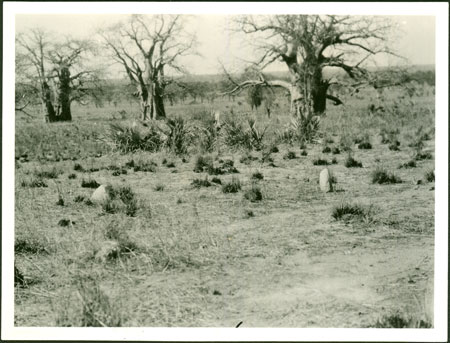Aka grave near Jebel Sillok

103 x 76 mm | Print gelatin silver
There are records relating to alternative images that we do not have scans for in the database:
1998.344.160.1 - Negative film nitrate , (103 x 76 mm)
1998.344.160.1 - Negative film nitrate , (103 x 76 mm)
Date of Print:
Unknown
Previous PRM Number:
EP.D.160
Previous Other Number:
O 8
Accession Number:
1998.344.160.2
Description:
Two grave stones, one placed either end of the grave cut, in the plain below the rocky hill Sillok, with Adansonia (Arabic, tebeldi) trees beyond.
There is not enough soil depth to bury people near the village on the hill top, necessitating the use of the plain below.
The language of the Aka people of Jebel Sillok is part of the Berta group of languages.
They called themselves Fa-c-aka or people of Aka.
Photographer:
Edward Evan Evans-Pritchard
Date of Photo:
1926 December
Region:
Blue Nile Jebel Sillok
Group:
Aka (Sillok)
PRM Source:
Edward Evan Evans-Pritchard
Acquired:
Donated 1966
Other Owners:
E. E. Evans-Pritchard Collection
Class:
Death , Topography , Vegetation
Keyword:
Grave
Documentation:
Original catalogue lists in Manuscript Collections. Additional material in related documents files. [CM 27/9/2005]
Primary Documentation:
PRM Accession Records - Accession Book Entry [p.
98] 1966.27 [1 - 24] G[ift] PROFESSOR E.
E.
EVANS-PRITCHARD; INST.
OF SOCIAL ANTHROPOLOGY, 51 BANBURY RD.
OXFORD - 1966.27.19 - S.
SUDAN, DARFUNG.
VARIOUS TRIBES.
Box of negatives in envelopes, [1 - 242] & 1966.27.20 - Box of prints of these negatives [refers to object 1966.27.19] [1 - 242], in envelopes.
Manual Catalogues [typewritten, entitled "Ingassana"] - 160. Grave. (Sillok). O.8
Note on print reverse ms pencil - "grave stones O.8"
Manual Catalogues [typewritten, entitled "Ingassana"] - 160. Grave. (Sillok). O.8
Note on print reverse ms pencil - "grave stones O.8"
Other Information:
In Ethnological Observations in Dar Fung, Sudan Notes and Records XV Part I, 1932, page 7, E.
E.
Evans-Pritchard notes that 'For burial, corpse is carried down the hill on his bedstead because there is no soil in which they can dig a grave on the hill itself.
They use the niche grave and it is marked outside by two stones, one at either end, a custom probably borrowed from the Arabs.
People are buried on their right side facing the south, wrapped in new cloth from head to foot.
They do not place anything inside the grave with the corpse.
A small child is buried in the hut itself.
For some months after death the dead man's son pours water over the grave.
Whilst there are many graves below I saw only one on the hill itself, and I was told that this was, in fact, the only grave on the hill, and that it belonged to a big chief of long ago, called Bakit.' [Chris Morton 13/2/2004]
Recorder:
Christopher Morton 13/2/2004 [Southern Sudan Project]

